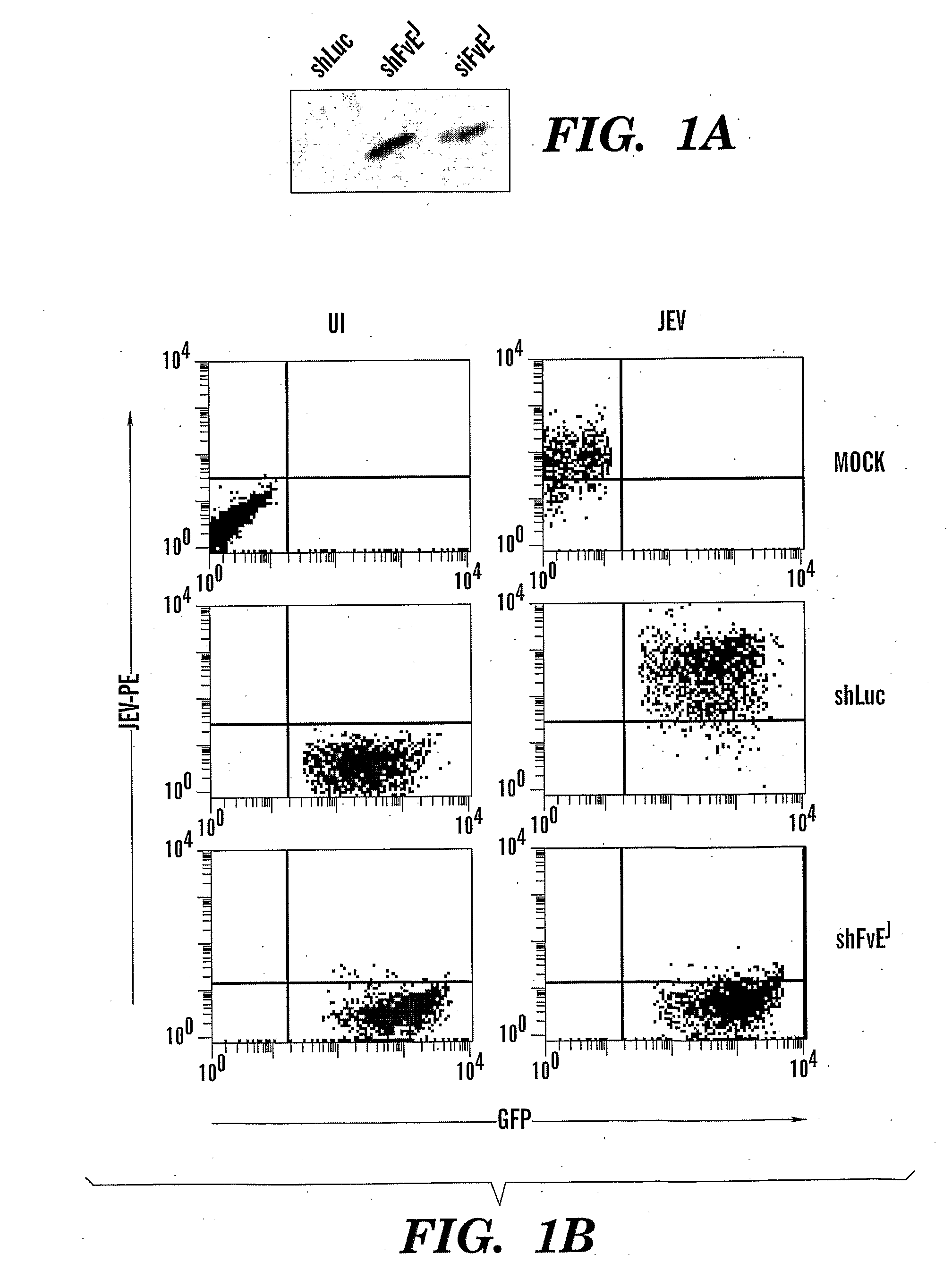Method to Treat Flavivirus Infection with siRNA
a technology of flavivirus and sirna, which is applied in the direction of viruses/bacteriophages, drug compositions, genetic material ingredients, etc., can solve the problems that using live and/or attenuated viruses pose a significant health risk to individuals with compromised immune systems, and achieve the effect of inhibiting expression
- Summary
- Abstract
- Description
- Claims
- Application Information
AI Technical Summary
Benefits of technology
Problems solved by technology
Method used
Image
Examples
example 1
Materials and Methods
Cells and Viruses
[0154]Baby hamster kidney (BHK21), the mouse neuronal cell line (Neuro 2a) and Vero cell lines were all obtained from ATCC and maintained in DMEM with 10% FCS. The Nakayama strain of JEV and B956 strain of WNV were obtained from ATCC, grown and plaque titrated using BHK21 cells for in vitro studies. Lethal dose (LD50) for both viruses was determined by inoculating serial dilutions of infected mouse brain lysates into groups of mice as described in24.
siRNA Sequence and Viral Vector to Express shRNA
[0155]The sequence of the siRNAs designed to target the envelope gene were as in Table 3. To generate a lentiviral vector to express shFvEJ, two complementary oligonucleotides incorporating FvEJ sequence were synthesized as a 21-nucleotide inverse repeat separated by a 9 nucleotide loop sequence and cloned in front of the U6 promoter in the lentiviral vector lentilox pLL3.7 as described by Rubinson et al16. A control vector targeting the luciferase gene...
example 2
[0172]Flaviviral genomes share a basic genomic structure. We selected several genes for siRNA targeting (FIG. 6A). The sense and antisense strands of the siRNAs were as follows and their genomic target sequences are presented in FIG. 6A:
FvCtarget:CTATCAATATGCTGAACGCG(SEQ ID NO: 96)sense:CUAUCAAUAUGCUGAACGCG(SEQ ID NO: 1)antisense:CGCGUUCAGCAUAUUGAUAG(SEQ ID NO: 2)FvEtarget:CGGATGTGGACTTTTCGGG(SEQ ID NO: 97)sense:CGGAUGUGGACUUUUCGGG(SEQ ID NO: 3)antisense:CCCGAAAAGUCCACAUCCG(SEQ ID NO: 4)FvNS3target:GACAGAAGGTGGTGTTTGAT(SEQ ID NO: 98)sense:GACAGAAGGUGGUGUUUGAU(SEQ ID NO: 5)antisense:AUCAAACACCACCUUCUGUC(SEQ ID NO: 6)FvR1target:CAGCATATTGACACCTGGG(SEQ ID NO: 99)sense:CAGCAUAUUGACACCUGGG(SEQ ID NO: 7)antisense:CCCAGGUGUCAAUAUGCUG(SEQ ID NO: 8)FvR2target:GGACTAGAGGTTAGAGGAG(SEQ ID NO: 100)sense:GGACUAGAGGUUAGAGGAG(SEQ ID NO: 9)antisense:CUCCUCUAACCUCUAGUCC(SEQ ID NO: 10)DEN-E3target:ACACAACATGGAACAATAG(SEQ ID NO: 104)sense:ACACAACAUGGAACAAUAG(SEQ ID NO: 32)antisense:CUAUUGUUCCAUGUUGUGU(...
example 3
[0177]Additional target sequences for siRNAs to inhibit flaviviruses and to treat flavivirus infection were deduced based upon regions that are conserved between different flavivirus serotypes. Table 4 contains target sequences conserved between West Nile virus and Japanese encephalitis virus. Table 5 lists sequences that are conserved between different Dengue virus serotypes.
TABLE 4Additional sequences conservedbetween JE and WN virusesIdentical in >18Targetresiduesgene (ntTarget sequenceSeqWNVJEVposition)(21 nt)ID(n = 31)(n = 22)NS35009-5029GGAACATCAGGCTCACCAATA10697%95%5054-5074GGGCTTTATGGCAATGGAGTC107100%13%A5223-5243TCTGCCACAGATCATCAAAGA10897%95%5293-5313GTGGCTGCTGAGATGGCTGAA10997%0%5407-5427CTCACCCACAGGCTGATGTCT11097%0%5458-5478GTGATGGATGAGGCTCATTTC11194%100%5654-5674GATACGAATGGATCACAGAAT11294%100%NS57974-7994GGAAGTCAGAGGGTACACAAA11394%100%8049-8069GGTCACCATGAAGAGTGGAGT11497%86%8321-8341ACTCCACGCACGAGATGTGTT11597%95%8705-8725CCATGGCCATGACTGACACTA116100%95%9103-9123GCCATTTGGTTC...
PUM
| Property | Measurement | Unit |
|---|---|---|
| Molar density | aaaaa | aaaaa |
| Molar density | aaaaa | aaaaa |
| Composition | aaaaa | aaaaa |
Abstract
Description
Claims
Application Information
 Login to View More
Login to View More - R&D
- Intellectual Property
- Life Sciences
- Materials
- Tech Scout
- Unparalleled Data Quality
- Higher Quality Content
- 60% Fewer Hallucinations
Browse by: Latest US Patents, China's latest patents, Technical Efficacy Thesaurus, Application Domain, Technology Topic, Popular Technical Reports.
© 2025 PatSnap. All rights reserved.Legal|Privacy policy|Modern Slavery Act Transparency Statement|Sitemap|About US| Contact US: help@patsnap.com



